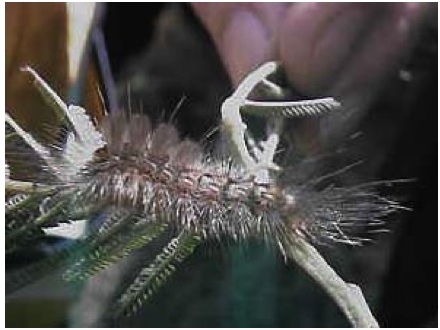PESTS AND DISEASES OF FORESTRY IN NEW ZEALAND
Painted apple moth update
Scion is the leading provider of forest-related knowledge in New Zealand
Formerly known as the Forest Research Institute, Scion has been a leader in research relating to forest health for over 50 years. The Rotorua-based Crown Research Institute continues to provide science that will protect all forests from damage caused by insect pests, pathogens and weeds. The information presented below arises from these research activities.
From Forest Health News No. 90, October 1999.
 The second discovery of Teia anartoides caterpillars (painted apple moth) on a residential property in the Auckland suburb of Panmure was reported by a resident in the last week of September. The Ministry of Agriculture and Forestry (MAF) initiated a survey to determine the extent of spread within a 300 metre radius which was completed on 3 October. The result was the finding of a large number of egg masses and caterpillars on 3 residential properties. The survey was then extended to cover a one kilometre radius zone in the Mt Wellington/Panmure area. Bad weather hampered its progress and it was not completed until the second week of October. The survey found infestations on a total of 11 properties (12 October) but this figure is in need of updating. Chlorpyrifos, an organo-phosphate insecticide commonly used to treat apples, pipfruit, stonefruit, kiwifruit and other crops as well as ornamentals for caterpillars, has been sprayed on host trees on the infested properties in an attempt to eradicate the moth. Any further spraying will use deltamethrin, a synthetic pyrethroid insecticide, as it can be used at extremely low dose rates. Host trees have also been removed where appropriate.
The second discovery of Teia anartoides caterpillars (painted apple moth) on a residential property in the Auckland suburb of Panmure was reported by a resident in the last week of September. The Ministry of Agriculture and Forestry (MAF) initiated a survey to determine the extent of spread within a 300 metre radius which was completed on 3 October. The result was the finding of a large number of egg masses and caterpillars on 3 residential properties. The survey was then extended to cover a one kilometre radius zone in the Mt Wellington/Panmure area. Bad weather hampered its progress and it was not completed until the second week of October. The survey found infestations on a total of 11 properties (12 October) but this figure is in need of updating. Chlorpyrifos, an organo-phosphate insecticide commonly used to treat apples, pipfruit, stonefruit, kiwifruit and other crops as well as ornamentals for caterpillars, has been sprayed on host trees on the infested properties in an attempt to eradicate the moth. Any further spraying will use deltamethrin, a synthetic pyrethroid insecticide, as it can be used at extremely low dose rates. Host trees have also been removed where appropriate.
The site of the new find is approximately 15 kilometres from Glendene, where painted apple moth eggs, caterpillars, pupae, and adults were found on 22 properties in May of this year (FHNews 85: 1-2, May 1999). In Glendene, the insect appeared to be confined to properties within one kilometre of the site of the original find (though surveys outside of this zone have not been conducted). Monitoring and treatment have continued in that area with the latest check indicating that control measures have been effective. Of the known 22 infested properties, caterpillars have been found again on 3 of them. The eradication attempt in Glendene has used chlorpyrifos which has been applied from the ground to host trees on the infested properties, as well as surfaces of buildings and other equipment or containers. Also, selected host trees were removed from infested properties as part of the control programme.
The Ministry of Agriculture and Forestry's Director of Forest Biosecurity, Dr Ruth Frampton, said there was no evidence to suggest that the Glendene and Mt Wellington/Panmure infestations were in any way linked. Dr Frampton believes that because the female moth does not fly, the natural spread of this pest will be limited to about 200-300 metre "hops" by ballooning caterpillars. However, no evidence has been provided by MAF to support this claim. It is Dr Framptons opinion that with the publicity the eradication campaign has received it is unlikely that any further populations will be found. This is despite the 6 month gap between the discovery of the first and second populations and that both populations are of a similar size and age! Dr Frampton has stated that the goal of the campaign was to eradicate the painted apple moth from the Glendene and Mt Wellington/Panmure infestation sites.
Geoff Ridley, Forest Research
This information is intended for general interest only. It is not intended to be a substitute for specific specialist advice on any matter and should not be relied on for that purpose. Scion will not be liable for any direct, indirect, incidental, special, consequential or exemplary damages, loss of profits, or any other intangible losses that result from using the information provided on this site.
(Scion is the trading name of the New Zealand Forest Research Institute Limited.)

 Farm Forestry New Zealand
Farm Forestry New Zealand

